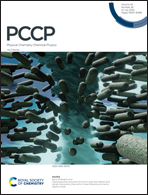Conductance and tunnelling current characteristics for individual identification of synthetic nucleic acids with a graphene device†
Abstract
Based on combined density functional theory and non-equilibrium Green's function quantum transport studies, in the present work we have demonstrated the quantum interference (QI) effect on the transverse conductance of Hachimoji (synthetic) nucleic acids when placed between the oxygen-terminated zigzag graphene nanoribbon (O-ZGNR) nanoelectrodes. We theorize that the QI effect could be well preserved in π–π coupling between a target nucleobase molecule and the carbon-based nanoelectrodes. Our study indicates that the QI effect, such as anti-resonance or Fano-resonance, affects the variation of transverse conductance depending on the nucleobase conformation. Furthermore, a variation of up to 2–5 orders of magnitude is observed in the conductance upon rotation for all the nucleobases. The current–voltage (I–V) characteristics results suggest a distinct variation in the electronic tunnelling current across the proposed nanogap device for all five nucleobases with the applied bias voltage ranges from 0.1–1.0 V. The different rotation angles keep the distinct feature of the nucleobases in both transverse conductance and tunnelling current features. Both features could be utilized in an accurate synthetic DNA sequencing device.



 Please wait while we load your content...
Please wait while we load your content...